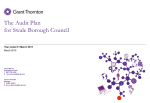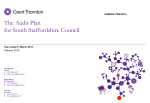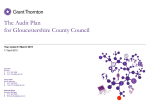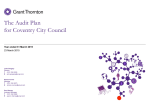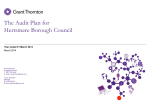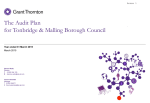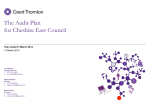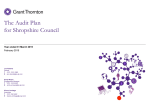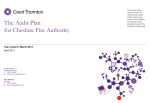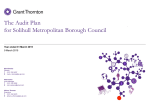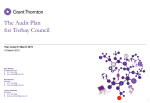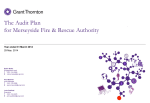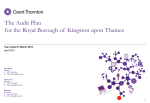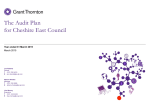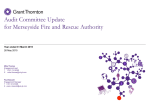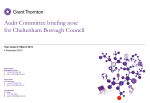Download The Audit Plan – template user guide
Transcript
The Audit Plan for Greater Manchester Fire and Rescue Service Year ended 31 March 2015 1 April 2015 Robin Baker Engagement Lead T 0161 214 6399 E [email protected] Paul Basnett Engagement Manager T 0161 214 6398 E [email protected] Jason Burgess Audit Executive T 0161 234 6390 E [email protected] © 2015 Grant Thornton UK LLP Greater Manchester Fire and Rescue Service Audit Plan 2014-15 . The contents of this report relate only to the matters which have come to our attention, which we believe need to be reported to you as part of our audit process. It is not a comprehensive record of all the relevant matters, which may be subject to change, and in particular we cannot be held responsible to you for reporting all of the risks which may affect the Service or any weaknesses in your internal controls. This report has been prepared solely for your benefit and should not be quoted in whole or in part without our prior written consent. We do not accept any responsibility for any loss occasioned to any third party acting, or refraining from acting on the basis of the content of this report, as this report was not prepared for, nor intended for, any other purpose. Contents Section 1. Understanding your business 2. Developments relevant to your business and the audit 3. Our audit approach 4. An audit focused on risks 5. Significant risks identified 6. Other risks 7. Group scope and risk assessment 8. Value for Money 9. Results of interim work 10. Key dates 11. Fees and independence 12. Communication of audit matters with those charged with governance Appendices A. Action plan © 2015 Grant Thornton UK LLP Greater Manchester Fire and Rescue Service Audit Plan 2014-15 Understanding your business In planning our audit we need to understand the challenges and opportunities the Service is facing. We set out a summary of our understanding below. Challenges/opportunities 1. Fire and Rescue collaboration 2. Financial pressures and efficiencies The Authority is exploring opportunities for collaboration and developing services against the priorities in "confronting the future". The Authority is facing significant financial challenges balancing service delivery against available resources at a time of reducing budgets. The Authority is now represented on the Greater Manchester Combined Authority which co-ordinates economic development, regeneration and transport functions. 3. Alternative Service Delivery 4. North West Fire Control The Authority is examining the development of alternative service delivery models for delivering services and accessing all available funding streams. The Authority has taken a leading role in establishing the new North West Fire Control Centre with its partners. Staff have transferred to the new company, to deliver a shared control room. Each partner has an equal share holding. New group accounting standards have been adopted for 2014/15 and are incorporated in the CIPFA Code of practice on Local Accounting. The Service needs to consider the new standards and whether group accounting is relevant to the 2014/14 financial statements. Our response We will discuss the Authority's current and future plans in these areas through our regular meetings with senior management and those charged with governance, providing a view where appropriate. We will review the progress you have made in delivering your efficiency savings in this area as part of our work on your arrangements for financial resilience. We will review the Authority's performance against the 2014/15 budget and undertake a review of financial resilience as part of VFM conclusion. © 2015 Grant Thornton UK LLP Greater Manchester Fire and Rescue Service Audit Plan 2014-15 We will discuss the impact of the development of alternative service delivery models with the Service through our regular meetings with senior management and those charged with governance, providing a view where appropriate. We will review managements processes and judgements, to help assess if the new standards have been appropriately considered Developments relevant to your business and the audit In planning our audit we also consider the impact of key developments in the sector and take account of national audit requirements as set out in the Code of Audit Practice ('the code') and associated guidance. Developments and other requirements 1.Pensions 2. Financial Reporting 3. Corporate Governance 4. Other requirements Changes to the Fire-fighters' pension schemes are due to be implemented from April 2015. Changes to the CIPFA Code of practice which relate to valuation of assets in line with the CIPFA Code ensuring that if a number of assets within a group are re-valued during the year, the remaining assets should also be considered for revaluation. As in previous years the Authority is required to summarise the operation of internal control in its Annual Governance Statement (AGS). The Authority is required to submit a Whole of Government accounts pack on which we provide an audit opinion. There are transitional arrangements in place for the introduction of the 2015 scheme there are changes planned to local government pension scheme for 2014/15 If a desk-top review of assets identified indicators of material change for some assets within a group, the review must consider if those indicators apply to the whole group. The Explanatory Foreword to the accounts is a key opportunity for the Authority to communication with its stakeholder. Our response We will discuss the proposed changes to the scheme on the Service during meetings with senior management. we will ensure that the changes are appropriately disclosed in the financial statements . © 2015 Grant Thornton UK LLP Greater Manchester Fire and Rescue Service Audit Plan 2014-15 We will ensure the Authority complies with the CIPFA Code of Practice through discussions with management and substantive testing. We will review the arrangements the Authority has in place for the production of the AGS . We will review managements arrangements to assess whether there are material differences between carrying and fair values of assets at 31 March 2015 and the accounting treatments in the 2014/15 financial statements. We will the AGS and Explanatory Foreword to consider whether they are consistent with our knowledge. We will carry out work on the WGA pack in accordance with HM Treasury requirements. Our audit approach Ensures compliance with International Standards on Auditing (ISAs) Global audit technology Understanding the environment and the entity Understanding the business Inherent risks Significant risks Understanding management’s focus Other risks Evaluating the year’s results Material balances Develop audit plan to obtain reasonable assurance that the Financial Statements as a whole are free from material misstatement and prepared in all materiala respects with the CIPFA Code of Practice framework using our global methodology and audit software Devise audit strategy (planned control reliance?) Yes Extract your data Test controls Test of detail IDEA Substantive Substantive Analyse data analytical analytical Report output using relevant review review to teams parameters Tests of detail General audit procedures Note: a. An item would be considered material to the financial statements if, through its omission or nondisclosure, the financial statements would no longer show a true and fair view. Financial statements Conclude and report Creates and tailors audit programs © 2015 Grant Thornton UK LLP Greater Manchester Fire and Rescue Service Audit Plan 2014-15 No Stores audit evidence Documents processes and controls Significant risks identified 'Significant risks often relate to significant non-routine transactions and judgmental matters. Non-routine transactions are transactions that are unusual, either due to size or nature, and that therefore occur infrequently. Judgmental matters may include the development of accounting estimates for which there is significant measurement uncertainty' (ISA 315). In this section we outline the significant risks of material misstatement which we have identified. There are two presumed significant risks which are applicable to all audits under auditing standards (International Standards on Auditing – ISAs) which are listed below: Significant risk Description Substantive audit procedures The revenue cycle includes fraudulent transactions Under ISA 240 there is a presumed risk that revenue may be misstated due to the improper recognition of revenue. Having considered the risk factors set out in ISA240 and the nature of the revenue streams received by the Authority. We have determined that the risk of fraud arising from revenue recognition can be rebutted, because: This presumption can be rebutted if the auditor concludes that there is no risk of material misstatement due to fraud relating to revenue recognition. Management over-ride of controls Under ISA 240 the presumption that the risk of management over-ride of controls is present in all entities. there is little incentive to manipulate revenue recognition: opportunities to manipulate revenue recognition are very limited ; revenue does not primarily involve cash transactions; and the culture and ethical framework of local authorities including Greater Manchester Fire and Rescue Authority mean that all forms of fraud are seen as unacceptable. Work completed to date: We have completed a review of the control environment for processing and posting journals which did not identify any issues to report Further work planned: We will: © 2015 Grant Thornton UK LLP Greater Manchester Fire and Rescue Service Audit Plan 2014-15 review the current year accounting estimates, judgments and decisions made by management test journal entries review unusual significant transactions; and agree the financial statements and disclosures to the general ledger Other risks identified "The auditor should evaluate the design and determine the implementation of the entity's controls, including relevant control activities, over those risks for which, in the auditor's judgment, it is not possible or practicable to reduce the risks of material misstatement at the assertion level to an acceptably low level with audit evidence obtained only from substantive procedures"(ISA 315). Reasonably possible risks are, in the auditor's judgement, other risk areas which they have identified as an area where the likelihood of material misstatement cannot be reduced to remote, without the need for gaining an understanding of the associated control environment, along with the performance of an appropriate level of substantive work. The risk of misstatement is lower than that for a Significant Risk, and they are not considered to be areas that are highly judgemental, or unusual in relation to the day to day activities of the business. Other risks Description of risk Work completed to date Work planned Employee remuneration Employee remuneration accruals understated: We will substantively test year-end payroll accruals. The Service has a large number of employees and related payroll transactions. As payroll is processed on eight separate payroll systems, seven of which are provided externally, this means the inherent risk, which include year-end accruals, is high. We have substantively tested a sample of transactions up to period 11 which confirmed the accuracy of payroll payments and existence employees with no issues arising. We will review and test the remuneration report and exit package disclosures. © 2015 Grant Thornton UK LLP Greater Manchester Fire and Rescue Service Audit Plan 2014-15 We have confirmed our understanding of the operation of controls for the payment of staff. Completion of our substantive testing of employees for accuracy of payment and agreement of employment remuneration disclosures to supporting records. Review of the monthly payroll reconciliation to ensure that information from the payroll system can be agreed to the ledger and financial statements. Other risks identified (continued) "The auditor should evaluate the design and determine the implementation of the entity's controls, including relevant control activities, over those risks for which, in the auditor's judgment, it is not possible or practicable to reduce the risks of material misstatement at the assertion level to an acceptably low level with audit evidence obtained only from substantive procedures"(ISA 315). Reasonably possible risks are, in the auditor's judgement, other risk areas which they have identified as an area where the likelihood of material misstatement cannot be reduced to remote, without the need for gaining an understanding of the associated control environment, along with the performance of an appropriate level of substantive work. The risk of misstatement is lower than that for a Significant Risk, and they are not considered to be areas that are highly judgemental, or unusual in relation to the day to day activities of the business. Other risks Description of risk Work completed to date Work planned Operating expenses Operating expenses /payables and accruals are understated or not recorded in the correct period We have confirmed our understanding of the operation of controls for the payment of creditors. We will test a sample expenditure, year end payables and accrual transactions to ensure they are correctly accounted for. There is an element of estimation uncertainty for accruals which may require estimation techniques and management judgment. We have substantively tested a sample of transactions up to period 11 with no issues to report. We will complete 'cut-off' testing of expenditure recorded in the 2015-16 general ledger to test for understated and unrecorded liabilities. There is an inherent risk that payables may not be posted in the correct financial year. © 2015 Grant Thornton UK LLP Greater Manchester Fire and Rescue Service Audit Plan 2014-15 Other risks identified (continued) "The auditor should evaluate the design and determine the implementation of the entity's controls, including relevant control activities, over those risks for which, in the auditor's judgment, it is not possible or practicable to reduce the risks of material misstatement at the assertion level to an acceptably low level with audit evidence obtained only from substantive procedures"(ISA 315). Reasonably possible risks are, in the auditor's judgement, other risk areas which they have identified as an area where the likelihood of material misstatement cannot be reduced to remote, without the need for gaining an understanding of the associated control environment, along with the performance of an appropriate level of substantive work. The risk of misstatement is lower than that for a Significant Risk, and they are not considered to be areas that are highly judgemental, or unusual in relation to the day to day activities of the business. Other risks Description of risk Work completed to date Work planned Fire fighters pension scheme Payments to pensioners are incorrectly calculated We will complete a predictive analytical review of pension payroll expenditure. Agree pension disclosures in the accounts to supporting evidence. Complete our testing pension payments for March 2015 to ensure they have been accurately accounted for and disclosed in the correct period Payments to retiring officers are low in volume but high in value and the service is reliant on effective controls both within and outside the organisation to ensure that payments made are valid and accurate. © 2015 Grant Thornton UK LLP Greater Manchester Fire and Rescue Service Audit Plan 2014-15 We have confirmed our understanding of the operation of controls for administering the pension payrolls and payments to retirees which includes verifying the existence or retired staff. We have substantively tested a sample of transactions up to period 11 to confirm eligibility and accuracy of lump sum payments. There are no issues to report. Value for money Value for money The Code requires us to issue a conclusion on whether the Service has put in place proper arrangements for securing economy, efficiency and effectiveness in its use of resources. This is known as the Value for Money (VfM) conclusion. Our VfM conclusion is based on the following criteria specified by the Audit Commission: VfM criteria Focus of the criteria The organisation has proper arrangements in place for securing financial resilience The organisation has robust systems and processes to manage financial risks and opportunities effectively, and to secure a stable financial position that enables it to continue to operate for the foreseeable future The organisation has proper arrangements for challenging how it secures economy, efficiency and effectiveness The organisation is prioritising its resources within tighter budgets, for example by achieving cost reductions and by improving efficiency and productivity © 2015 Grant Thornton UK LLP Greater Manchester Fire and Rescue Service Audit Plan 2014-15 The Authority has well established arrangements ensuring that it is using scarce resources effectively and has a good track record of delivering planned savings. Our work will consist of updating our knowledge of the Authority from 2013/14. and undertaking an initial a risk assessment to identify areas of risk to our VfM conclusion. We will undertake work for the following areas to address the risks identified. ● reviewing the Authority's AGS. ● reviewing progress and delivery of planned savings in 2014/15 and plans for future years. ● updating our understanding of your MTFS in light of the 2015/16 grant settlement announced by the Government. ● monitoring governance arrangements particularly around partnership working including the Authority's work with the Community Risk Intervention Team and North West Fire Control. ● The results of our VfM audit work and the key messages arising will be reported in our Audit Findings report and in the Annual Audit Letter. Results of interim audit work The findings of our interim audit work, and the impact of our findings on the accounts audit approach, are summarised in the table below: Internal audit Work performed and findings Conclusion We have completed a high level review of internal audit's overall arrangements. Our work has not identified any issues which we wish to bring to your attention Overall, we have concluded that the internal audit service continues to provide an independent and satisfactory service to the Authority and that internal audit work contributes to an effective internal control environment at the Authority We also reviewed internal audit's work on the Service's key financial systems to date. We have not identified any significant weaknesses impacting on our responsibilities. Walkthrough testing We have completed walkthrough tests of controls operating in areas where we consider that there is a risk of material misstatement to the financial statements. Our review of internal audit work has not identified any weaknesses which impact on our audit approach. Our work has not identified any weaknesses which impact on our audit approach Our work has not identified any issues which we wish to bring to your attention. Internal controls have been implemented in accordance with our documented understanding. Entity level controls We have obtained an understanding of the overall control environment relevant to the preparation of the financial statements including: • Communication and enforcement of integrity and ethical values • Commitment to competence • Participation by those charged with governance • Management's philosophy and operating style • Organisational structure • Assignment of authority and responsibility • Human resource policies and practices © 2015 Grant Thornton UK LLP Greater Manchester Fire and Rescue Service Audit Plan 2014-15 Our work has identified no material weaknesses which are likely to adversely impact on the Authority's financial statements Results of interim audit work cont'd Review of information technology controls Work performed Conclusion We have performed a high level review of the general IT control environment and the material financial systems (Agresso (ledger) and i-trent (payroll), as part of the overall review of the internal controls system. Our work has identified no material weaknesses for the ledger and payroll systems which are likely to adversely impact on the 2014/15 financial statements. We have requested the ICT department to provide an update to the recommendation from review last year and to complete a selfassessment to refresh the results from general IT control review in 2013/14. Journal entry controls Early substantive testing At the year end we will review the response from the ICT department and assess the impact of any risks identified. We have reviewed the Service's journal entry policies and procedures as part of determining our journal entry testing strategy and have not identified any material weaknesses which are likely to adversely impact on the Service's control environment or financial statements. Our work has identified no material weaknesses which are likely to adversely impact on the Service's financial statements. We have tested a sample of precept and government grant receipts received up to period 11. Our work has identified no material weaknesses which are likely to adversely impact on the Authority's financial statements We have reviewed the principal control account reconciliations performed by the Service's finance team and by its financial reporting provider, Wigan MBC. Overall, the majority of reconciliations are completed on a timely basis. However, the sundry debtors account reconciliation for the months ending May, June and July 2014, were prepared in August 2014. The reconciliations for August and September 2014 were prepared in October 2014. In addition there was no clear evidence of review of the reconciliation by a senior officer. See appendix A for further details. Value for money We have undertaken a risk assessment to identify areas of risk to our VfM conclusion, updating our knowledge of the Service from 2013/14. © 2015 Grant Thornton UK LLP Greater Manchester Fire and Rescue Service Audit Plan 2014-15 We have not identified any material risks to the VfM conclusion from our initial risk assessment. Key dates The audit cycle Mar 2015 Interim audit visit July – August 2015 Final accounts Visit September 2015 Completion/ reporting November 2015 Debrief Key phases of our audit 2014-2015 Date Activity March 2015 Planning March 2014 Interim site visit June 2015 Presentation of audit plan to Authority July 2015 Year end fieldwork August 2015 Audit findings clearance meeting with finance team September 2015 Report audit findings to those charged with governance (Authority) September 2015 Sign financial statements opinion © 2015 Grant Thornton UK LLP Greater Manchester Fire and Rescue Service Audit Plan 2014-15 Fees and independence Fees Fees for other services £ Service audit Total fees (excluding VAT) 52,992 Service Planned Fees £ Provision of the tax helpline and professional tax services 5,700 52,992 Our fee assumptions include: Fees for other services Supporting schedules to all figures in the accounts are supplied by the agreed dates and in accordance with the agreed upon information request list We have recently agreed to provide non-audit services relating to tax advisory services to the Authority. From 2014/15 the provision of a helpline is an annual cost of £5,700 with the option to take up additional consultancy services if desired. We are satisfied that this work does not impact on our independence and appropriate safeguards are in place to ensure that this continues to be the case. The scope of the audit, and the Service and its activities, have not changed significantly The Service will make available management and accounting staff to help us locate information and to provide explanations Grant certification Fees for other services reflect those agreed at the time of issuing our Audit Plan. Any changes will be reported in our Audit Findings Report and Annual Audit Letter. Independence and ethics We confirm that there are no significant facts or matters that impact on our independence as auditors that we are required or wish to draw to your attention. We have complied with the Auditing Practices Board's Ethical Standards and therefore we confirm that we are independent and are able to express an objective opinion on the financial statements. Our fees for grant certification cover only housing benefit subsidy certification, which falls under the remit of Public Sector Audit Appointments Limited, Full details of all fees charged for audit and non-audit services will be included in our Audit Findings report at the conclusion of the audit. as the successor to the Audit Commission in this area. We confirm that we have implemented policies and procedures to meet the requirement of the Auditing Practices Board's Ethical Standards. Fees in respect of other grant work, such as reasonable assurance reports, are shown under 'Fees for other services.' © 2015 Grant Thornton UK LLP Greater Manchester Fire and Rescue Service Audit Plan 2014-15 Communication of audit matters with those charged with governance International Standards on Auditing (ISA) 260, as well as other ISAs, prescribe matters which we are required to communicate with those charged with governance, and which we set out in the table opposite. This document, The Audit Plan, outlines our audit strategy and plan to deliver the audit, while The Audit Findings will be issued prior to approval of the financial statements and will present key issues and other matters arising from the audit, together with an explanation as to how these have been resolved. Our communication plan Audit Audit plan findings Respective responsibilities of auditor and management/those charged with governance Overview of the planned scope and timing of the audit. Form, timing and expected general content of communications We will communicate any adverse or unexpected findings affecting the audit on a timely basis, either informally or via a report to the Service. Views about the qualitative aspects of the entity's accounting and financial reporting practices, significant matters and issue arising during the audit and written representations that have been sought Respective responsibilities Confirmation of independence and objectivity This plan has been prepared in the context of the Statement of Responsibilities of Auditors and Audited Bodies issued by the Audit Commission (www.auditcommission.gov.uk). A statement that we have complied with relevant ethical requirements regarding independence, relationships and other matters which might be thought to bear on independence. We have been appointed as the Service's independent external auditors by the Audit Commission, the body responsible for appointing external auditors to local public bodies in England. As external auditors, we have a broad remit covering finance and governance matters. Details of non-audit work performed by Grant Thornton UK LLP and network firms, together with fees charged. Our annual work programme is set in accordance with the Code of Audit Practice ('the Code') issued by the Audit Commission and includes nationally prescribed and locally determined work. Our work considers the Service's key risks when reaching our conclusions under the Code. It is the responsibility of the Service to ensure that proper arrangements are in place for the conduct of its business, and that public money is safeguarded and properly accounted for. We have considered how the Service is fulfilling these responsibilities. © 2015 Grant Thornton UK LLP Greater Manchester Fire and Rescue Service Audit Plan 2014-15 Details of safeguards applied to threats to independence Material weaknesses in internal control identified during the audit Identification or suspicion of fraud involving management and/or others which results in material misstatement of the financial statements Non compliance with laws and regulations Expected modifications to the auditor's report, or emphasis of matter Uncorrected misstatements Significant matters arising in connection with related parties Significant matters in relation to going concern Appendices © 2015 Grant Thornton UK LLP Greater Manchester Fire and Rescue Service Audit Plan 2014-15 Appendix A: Action plan Rec No. 1 Recommendation Priority Ensure that all control account reconciliations are prepared on a timely basis and are signed and dated by both the preparer and reviewer. Low Priority High - Significant effect on control system Medium - Effect on control system Low - Best practice © 2015 Grant Thornton UK LLP Greater Manchester Fire and Rescue Service Audit Plan 2014-15 Management response Implementation date & responsibility From April 2015 Appendix B: An audit focused on risks We undertake a risk based audit, focussing audit effort on those areas where we have identified the highest risk of material misstatement in the financial statements. The table below shows how our audit approach focuses on the risks we have identified through our planning and review of the national risks affecting the sector. Definitions of the level of risk and associated work are given below: Significant – Significant risks are typically non-routine transactions, areas of material judgement or those areas where there is a high underlying (inherent) risk of misstatement. The International Standards on Auditing identify two overall significant risks inherent in any financial statements. These are separately disclosed in the significant risks table on page 7. Reasonably Possible – Reasonably Possible risks of material misstatement are typically those transaction cycles and balances where there are high values, large numbers of transactions and risks arising from, for example, system changes and issues identified from previous years audits. We will assess controls and undertake extended substantive testing. Cycles where we have identified a reasonably possible risk of material misstatement are outlined in full on pages 8 and 9 along with full details of the proposed testing None – Our risk assessment has not identified a risk of misstatement. We will undertake substantive testing of material balances. Where an item in the financial statements is not material we do not carry out detailed substantive testing. Section of the financial statements Material (or potentially material) balance? Description of Risk Inherent risk Material misstatement risk identified? Inherent Risk Assessment Will substantive testing be carried out? Operating Expenditure Yes Operating expenses are misstated Medium Reasonably Possible Total resource expenditure in 2013-14 was £49.5m (excluding staff costs) with a high volume of transactions being processed through the Accounts Payable system. We have therefore assessed the inherent risk as medium. Employees Pay Yes Employee Remuneration accruals are misstated Medium Reasonably Possible The 2013-14 accounts reported staff costs of £70m. There is therefore a high number of monthly transactions which are processed on eight separate systems of which seven are provided externally. Staff costs are a significant proportion of running costs. Based on this information we have assessed the inherent risk as medium. © 2015 Grant Thornton UK LLP Greater Manchester Fire and Rescue Service Audit Plan 2014-15 Appendix B: An audit focused on risks (continued) Section of the financial statements Material (or potentially material) balance? Description of Risk Inherent risk Material misstatement risk identified? Inherent Risk Assessment Will substantive testing be carried out? Fire Fighters pension scheme Yes Payments to pensioners incorrectly calculated and claims liability understated Medium Reasonably Possible In the 2013-14 accounts the Service reported total pension payments of £46.2m. There is a high number of monthly transactions. We have therefore assessed the inherent risk as medium. Finance Costs No Operating expenses are misstated Low None The balance is below materiality therefore risks are deemed to be low. Government Grants Yes Government Grant contributions are not recorded correctly Low None The funding from Central Government is made up of a low volume of high value transactions. We have therefore assessed the inherent risk associated with revenue recognition as low. Council Tax Precepts Yes Capital and revenue grants/contributions are not accounted for appropriately Low None In 2013-14 the Service received £38.9m which were from a low volume of transactions. We have therefore assessed the inherent risk associated with revenue recognition as low. Property, Plant and Equipment Yes Allowance for depreciation not adequate Low None The depreciation balance is comprised of a low volume of high value transactions. We have therefore assessed the inherent risk as low. Intangible Assets Yes Allowance for amortisation not adequate Low None The amortisation balance is comprised of a low volume of high value transactions . We have therefore assessed the inherent risk as low. Inventories No Inventory prices and quantities are not valid Low None In the 2013-14 accounts the balance disclosed was not material and therefore the risk is deemed to be low. Trade and Other Receivables Yes Recorded debtors are misstated Low None Debtors is comprised of a high volume of routine low value transactions. We therefore assess the inherent risk associated with debtors to be low. © 2015 Grant Thornton UK LLP Greater Manchester Fire and Rescue Service Audit Plan 2014-15 Appendix B: An audit focused on risks (continued) Section of the financial statements Material (or potentially material) balance? Description of Risk Inherent risk Material misstatement risk identified? Inherent Risk Assessment Will substantive testing be carried out? Cash and cash equivalents Yes Cash misappropriated Low None Handled cash is low in volume and value we have deemed the inherent risk to be low. Trade and Other Payables Yes Creditors understated or not recorded in the correct period Medium Medium The payables figure in 2013-14 was £12.9m, with a significant number of transactions occurring around the year end. The year-end balance also includes a number of accruals with a high value and requiring management judgements. We have therefore deemed the inherent risk to be medium. Other Borrowings Yes We have not identified a risk of material misstatement Low None The balance is comprised of a very low volume of high value transactions, therefore the inherent risk is deemed low. Provisions Yes We have not identified a risk of material misstatement Low None The provisions figure in the 2013-14 accounts was £2.1m which included a number of provisions which are low in volume but high value. We have assessed the inherent risk to be low. Retirement Benefit Obligations Yes We have not identified a risk of material misstatement Low None The Actuarial valuations are provided at the year end and are recorded in the general ledger through a low volume of high value transactions The inherent risk is deemed to be low. Usable and unusable reserves Yes We have not identified a risk of material misstatement Low None The balance is comprised of a very low volume of high value transactions therefore inherent risk is deemed to be low. © 2015 Grant Thornton UK LLP Greater Manchester Fire and Rescue Service Audit Plan 2014-15 © 2015 Grant Thornton UK LLP. All rights reserved. 'Grant Thornton' means Grant Thornton UK LLP, a limited liability partnership. Grant Thornton is a member firm of Grant Thornton International Ltd (Grant Thornton International). References to 'Grant Thornton' are to the brand under which the Grant Thornton member firms operate and refer to one or more member firms, as the context requires. Grant Thornton International and the member firms are not a worldwide partnership. Services are delivered independently by member firms, which are not responsible for the services or activities of one another. Grant Thornton International does not provide services to clients. grant-thornton.co.uk






















